This post is in partnership with Gilmour Garden and Watering. All thoughts and words are my own.
It’s here—summer summer summertiiiime. Or should I say, it’s been here, as we’ve been feelin’ the heat for the past few weeks with seemingly no end in sight.
My high desert garden is accustomed to the sultry weather this time of year, but it’s not any easier on the plants than it is on me. We have a full south-facing garden and July through August are generally the hottest months for us. Low precipitation this year has meant a dry, dusty summer and rationing of our local irrigation.
In this sweltering weather, keeping the garden cool and well-watered is key to helping plants survive. Even with drip irrigation installed in my yard, I find that I still need to supplement with hand watering during drought and heat spells.
Disclosure: If you shop from my article or make a purchase through one of my links, I may receive commissions on some of the products I recommend.
I keep a few sets of Gilmour’s Flexogen Super Duty Hoses paired with their Heavy Duty Thumb Control Watering Nozzles in different parts of the yard, and have been using them for the past several years to water our containers and hard-to-reach corners.
Having tested all types of nozzles over the years, I’ve discovered that I really like having a thumb control. The water turns on and stays on, without me needing to squeeze a trigger—no more achy hand after a day in the garden!
It’s almost life-changing when you’re someone who spends a considerable amount of time outside (and I’ve actually started replacing all my trigger squeeze nozzles with this thumb control model).
I can easily adjust the water flow with my thumb as I move from plant to plant, and I’m always a fan of pattern nozzles, which offer so much more versatility than a standard spray nozzle.
As for the hose, well, it’s a hose—it works, it’s relatively lightweight, and so far it’s burly enough to take some abuse in the garden. (I am definitely not one to be gentle on my gardening gear!) The thickness of the material also seems to help keep the hose from kinking.
But the thing I like most about it is actually the neutral gray color and glossy coating. While this may sound superficial, the color and coating resists dirt very well—a huge plus in my book.
I have some lighter-colored hoses, and a slight annoyance with them is the fact that they seem to grab onto every speck of dirt and look really grubby pretty fast. (I use and abuse my hoses, remember?)
I guess some people would prefer function over form, but putting my hands on a grimy hose deflates the fun of watering a bit (which, for me, is already more a chore than a meditation). So if a hose can stay clean and sharp-looking as well as get the job done, I’m all for it.
To help your plants switch to summer survival mode—while being mindful of our limited resources—here are my top seven tips for hot weather watering, all gathered from personal experience.
1. Time your watering for the morning or late afternoon.
The best time to water your garden in summer is from 5 am to 9 am—before the heat of the day sets in, giving your soil plenty of time to drink up before the water evaporates and any moisture on leaves to dry off before nightfall.
If watering in the morning isn’t possible, the next best time—in general—is from 5 pm to 8 pm. This will depend on your local climate, as people in warmer regions will still experience pretty hot temperatures during those late afternoon hours, and can get away with watering later in the evening.
But unless you live in an arid climate, try to avoid watering too late at night, as cool and wet conditions could encourage fungi and slime mold, lead to increased slug activity, and invite sow bugs, earwigs, and other pests into your garden.
Related: Get rid of pests with this 2-ingredient homemade insecticide
But all told, don’t worry if all you can do is a midday watering—any water is better than none at all, and the oft-repeated belief that watering on a hot sunny day will damage your plants is a gardening myth that’s been debunked by science.
Sunburn (which often appear as bleached areas on the foliage of young transplants, heat-sensitive plants, and distressed, underwatered plants) is caused by simple overexposure to the sun, not by water droplets that supposedly magnify the sun and scorch the leaves.
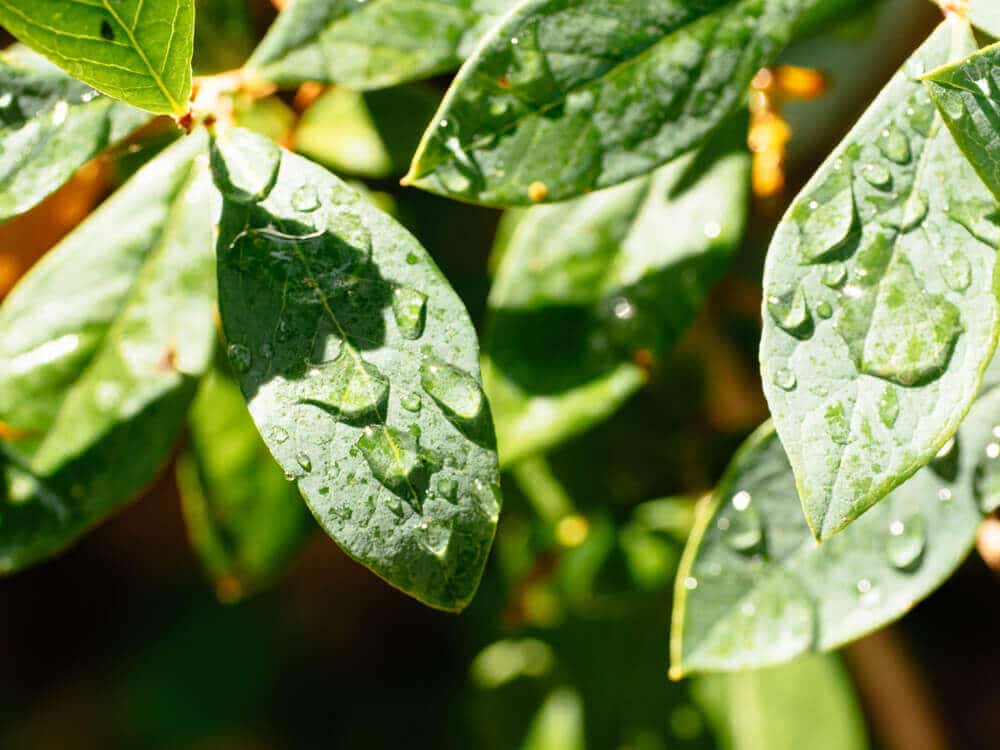
There are good reasons for not watering in the middle of the day under a blazing hot sun, but leaf scorch is not one of them.
In the morning, the air and soil are cooler, which minimizes evaporation. The lack of wind means you avoid wasting water to wind drift.
And most importantly, plants absorb water more readily when they’re not under heat stress—a condition that’s more likely to occur when the sun is at its peak.
So while it’s perfectly okay to water plants while they’re in full mid-day sun, it’s not the most efficient way to go about it.
2. Water well and water deeply.
Just like people, plants need thorough hydration during times of excess heat. This is especially true of outdoor container plants, as well as new plantings that haven’t yet established their roots.
Read more: How to grow tomatoes in pots
Container plants—particularly those in smaller pots, fabric pots, clay pots, and baskets lined with coco fibers or sphagnum peat moss—are more susceptible to drying out than their in-ground counterparts.
In the height of summer, these potted plants need special attention and may require watering every day or even up to three times a day.
A good rule of thumb is to water when the first 2 inches of potting soil feels dry. The smaller or more porous your container, the more you’ll have to water it.
Both annual and perennial plants in the ground benefit from a good deep soaking up to three times a week. Allowing the water to penetrate slowly and fully into the soil (to a depth of at least 6 inches) encourages roots to grow deeper and stronger and protects them from the parched soil surface.
Remember: Infrequent deep soakings are better than frequent light sprinklings. Aim the water right where it’s needed—at the root zone of your plants—to reduce the chances of runoff and evaporation.
How do you know when to water?
Establish an “indicator” plant in your garden—one with large, succulent leaves that are prone to drooping when the soil is dry.
Squash and melons are good indicator plants, as their leaves lose a lot of moisture fast. When you see your squash leaves start to wilt, it’s a sign that your garden could use a good soak.
Quick Tip
If your plants look sad and droopy, first feel the top couple inches of soil around the root zone. Does it feel nice and moist? If so, more water is not what your plants need! They are simply coping with the heat and will perk up again once temperatures cool down.
During periods of extremely dry, hot weather, I also like to give my plants (especially the more fragile or heat-sensitive ones) a gentle overhead shower using the “garden” setting on Gilmour’s thumb control watering nozzle (a full, consistent spray similar to a soft rain), or running a sprinkler over my garden beds.
From a conservation standpoint, it’s not the most economical use of water, but there are times when it’s called for to promote a healthy garden.
In dry, windy weather, a fine layer of dust can build up on your plants and reduce their ability to photosynthesize efficiently.
Heat-stressed plants are also more prone to pests like aphids, which can naturally be controlled by a sharp blast of water. (I like the “jet” setting on the nozzle for this purpose.)
And finally, a quick, cooling shower can offer relief to a drooping plant, as it helps lower leaf temperature and prevent heat stress.
Other hose nozzles I recommend:
- Gilmour Heavy Duty Thumb Control Nozzle with Swivel Connect
- Gilmour Heavy Duty Compact Watering Wand with Swivel Connect
3. Use drip irrigation or soaker hoses.
Don’t get me wrong, there’s always a place for garden hoses and manual watering in the yard (especially for newly seeded beds, young seedlings, and tempering the effects of crazy heat waves).
But to make sure all your plants receive consistent moisture throughout the year, the best way to water them is with drip irrigation or soaker hoses. I put mine on an automatic timer with a rain sensor, so on days I forget or don’t have time to water, I’m not worrying about my plants wilting.
If you’re still hand-watering everything, it’s worth it to install a drip irrigation system to take some of the workload off in high season.
I like to use a combination of drip lines and soaker hoses—they both water at the root zone, but emit the moisture differently. Soaker hoses aren’t as configurable as drip systems, but are much easier to set up if you want to start small first (or have simple needs).
Read more: What I recommend as the the best soaker hoses
4. Promote high humidity.
Plants that like it humid, such as bananas, ferns, ginger, hibiscus, and elephant ears, should be misted frequently during periods of dry, hot weather.
The “flower” or “soft wash” settings on the nozzle are perfect for delivering a delicate, uniform spray of water to these moisture-loving plants.
If it’s particularly breezy, you may need to mist them a couple times a day and give the garden a second watering in the late afternoon to increase humidity.
Container plants should be grouped together to increase humidity, and they especially benefit from being placed under the canopy of larger plants or trees.
5. Shield heat-sensitive plants from excessive sun.
A heat wave is hardest on new transplants that haven’t had time to develop a strong root system (including drought-tolerant transplants, which—contrary to popular belief—still need regular watering for the first year while they get established).
Worth a read: Why and how to plant your tomatoes sideways in a trench
If your plants are in containers, move them to an area of the yard that’s partially shaded in the afternoon. Transplants that need to go in the ground sooner than later should be hardened off first, then planted in the garden where they get only dappled light or afternoon shade.
Quick Tip
Grow new transplants next to taller annuals or deciduous perennials that offer some cover. By the time the new plants establish roots and require full sun, those taller plants will have died back.
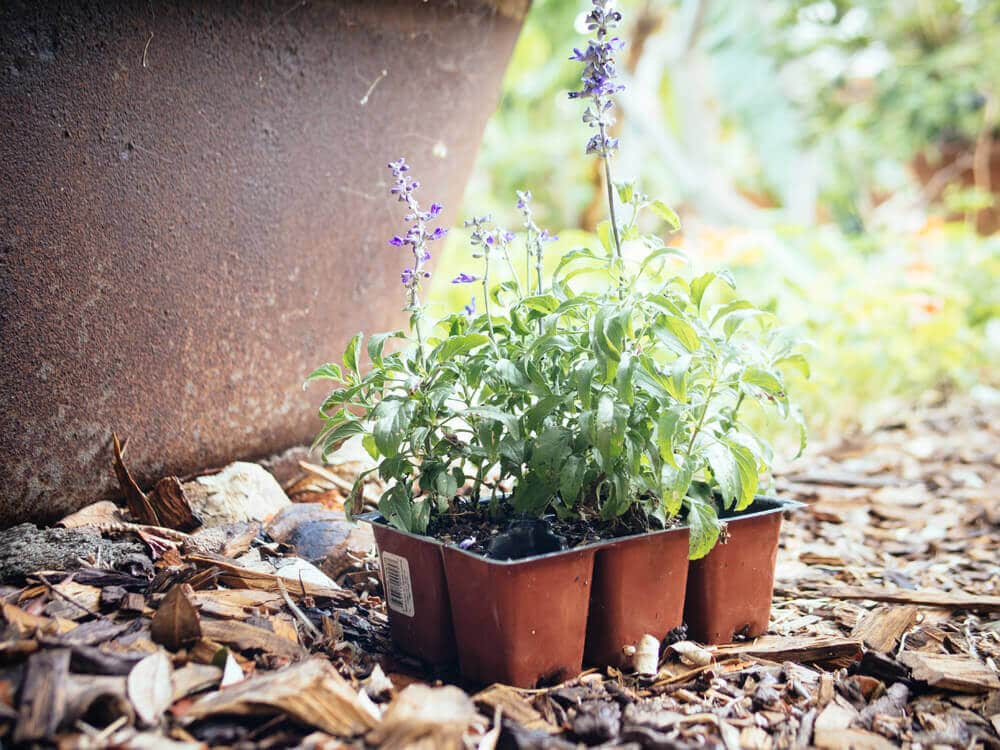
Other plants in the ground can be protected by shade cloth or row cover, which still lets in light and water but blocks a specific amount of sun (called a “shade factor”) from 25 percent to 90 percent, depending on its configuration.
Recommended shade cloth covers:
Giving a bit of afternoon shade is a good idea even for heat-loving leafy greens or heat-tolerant lettuce, as it extends their season and keeps them from bolting too early.
In a pinch, even a white (or light-colored) bed sheet strung across your garden bed or draped over your plant cages will work. The sheet lets in all the warmth and light of the day while shading your plants and reflecting light off of them at the same time. (If you don’t have any old bed sheets laying around, check your local thrift shops.)
6. Don’t fertilize during a heat wave.
Very high soil temperatures (above 85°F) can cause plants to go semi-dormant, so they use very few nutrients while they’re in survival mode and aren’t prepared to make use of them.
If you fertilize your plants while they’re stressed, it may even damage them. Sounds counterintuitive, right? But fertilizing stressed plants just stresses them even more.
That’s because fertilizers fuel new growth, and a heat-stressed plant simply cannot keep up with the pressure of putting out new leaves. An increase in the amount of water needed to move nutrients through a plant can also take its toll if a plant is already suffering from dry or inconsistently moist soil.
Withhold the fertilizers (or apply a weaker diluted solution) until the weather cools off a bit and your plants have a chance to recover.
When I need to give my plants a quick nutritional boost in high summer, I make sure the soil is evenly moist first (to reduce heat stress and improve absorption) and use a half-strength organic liquid fertilizer right at the root zone.
My go-to liquid feed is this fish and seaweed emulsion, which I’ve used all over my vegetable gardens for years.
7. Keep as much moisture in the ground as possible.
This really should be the number-one tip, but I hope that adding it last ensures you won’t forget it!
An organic mulch like shredded bark, arborist wood chips, or straw (not run-of-the-mill hay—you don’t want to introduce all those weed seeds to your garden) conserves moisture, smothers weeds, regulates soil temperature to keep plant roots cool in summer, and adds small amounts of nutrients to the soil as it breaks down.
It also prevents soil (and whatever fungi and bacteria are lingering in the ground) from splashing up on the leaves while watering, which reduces the spread of disease.
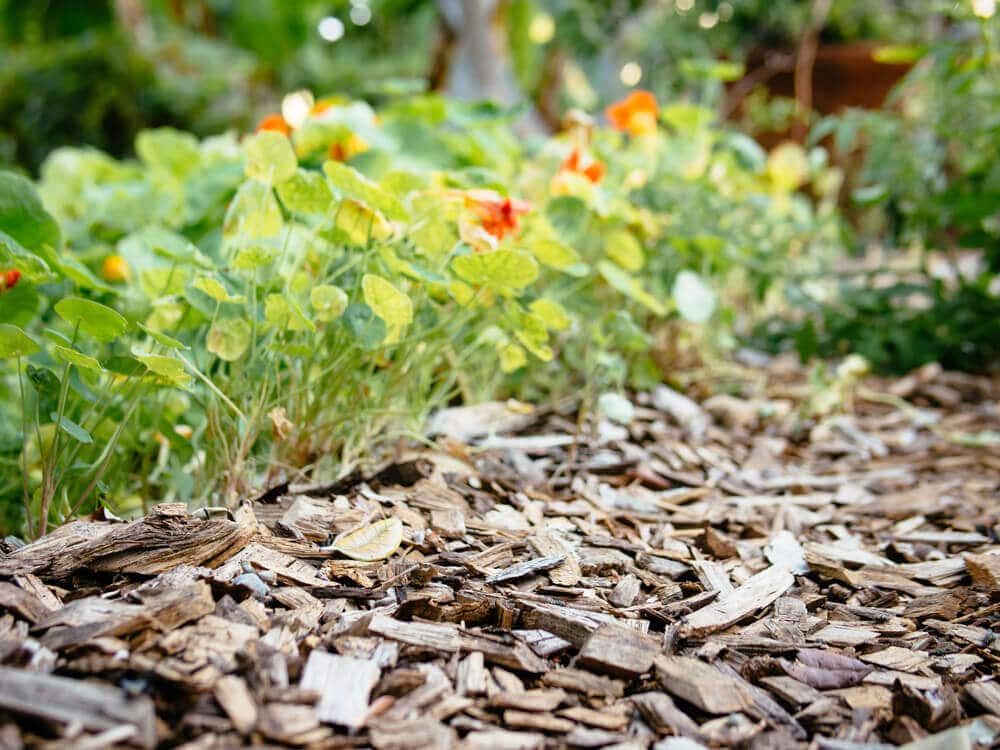
Add a 2- to 3-inch layer of mulch on top of the soil, being careful not to pile it up around the base of your plants (as it can hold too much moisture against the stems and lead to rotting).
An initial application of mulch should take you through one full season, but you should replenish the mulch as needed throughout the year.
During intensely hot weather, don’t be afraid to layer it on thicker—up to 4 inches, if needed, to shade the soil from heat and sun.
Common questions about watering in hot weather
Is it bad to water plants with hot water?
It’s probably happened to all of us at some point: You left the garden hose out in the sun all day, then turned on the water and inadvertently showered your plants with hot water. Are they doomed?
Well, it depends. Boiling hot water is a very effective remedy for controlling weeds and pests when poured directly on them.
But… If the hot water merely splashed on your plant or landed on the leaves for just a couple seconds, your plant will likely survive. If the hot water ended up on the soil only, then it’s even less of a concern.
As long as the soil was mulched to protect the crown and roots of the plant from overheating, and the leaves remained dry, it’s okay if you (unintentionally or not) watered your plants with hot water.
How hot is too hot for plants?
In temperatures that are consistently above 85°F, most plants start to lose moisture fast, a condition that’s manifested by a drooping leaf.
This is also the tipping point for vegetable crops like tomatoes, squash, and cucumbers, which may not flower or fruit in excessively hot weather.
What do overwatered plants look like?
When a plant is overwatered, the color of the leaves starts to change. You might see splotches of yellow appearing on the surface, or vibrant green leaves turning pale green or yellow.
This happens because the plant can’t photosynthesize properly when the soil is too wet. Plants need oxygen and overwatering effectively suffocates them.
How much water do vegetables need in hot weather?
A general guideline is to give your vegetables at least 1 inch of water per week, either by rain or irrigation. In dry climates or dry sandy soil, double that number (up to 2 inches per week).
And in hot weather, vegetables need even more water, up to a 1/2 inch extra per week for every 10 degrees that the average temperature is above 60°F.
You can calculate the average temperature by adding the daytime high plus the nighttime low, then dividing by 2. So if your daytime high is 95 and nighttime low is 70, the average is 82.5. In this case, your garden would need at least another inch of water in peak summer.
Does watering grass in the sun burn it?
Even if you water your grass on the hottest, sunniest day, your grass will not burn. In fact, it will only make it healthier.
Just like the myth about watering leaves on a hot day, water droplets on grass will not magnify the sun and scorch the blades. You’re more likely to burn your grass by not watering during extreme heat, or by applying too much fertilizer.
More recommended reading:
This post is sponsored by Gilmour Garden and Watering. View my full advertising disclosure.
This post updated from an article that originally appeared on August 24, 2017.


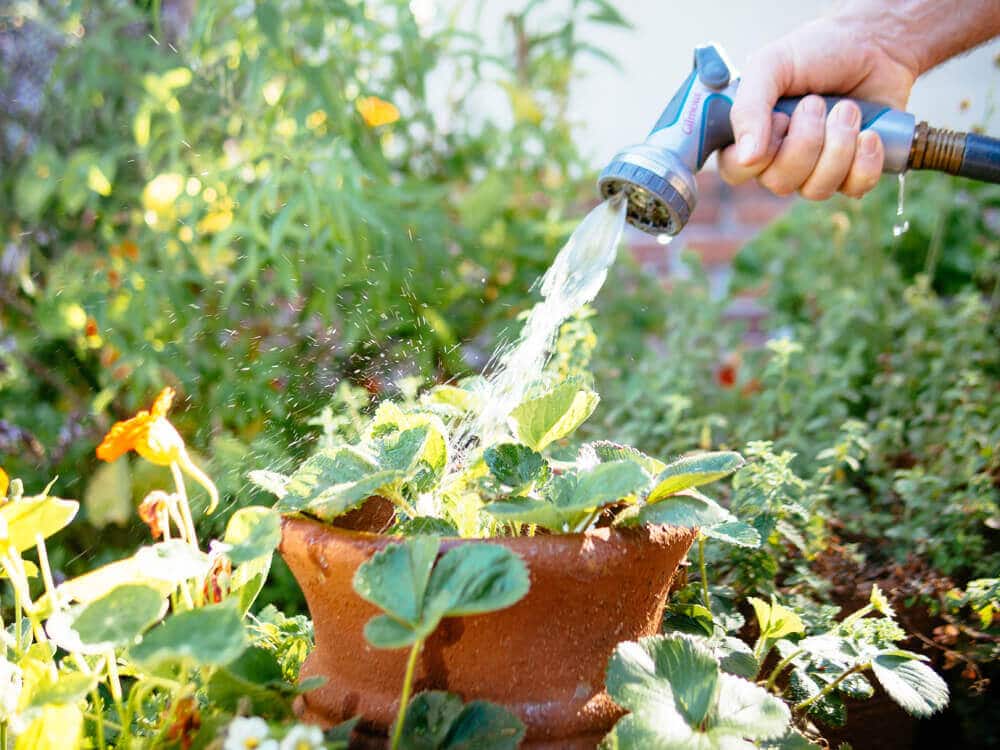
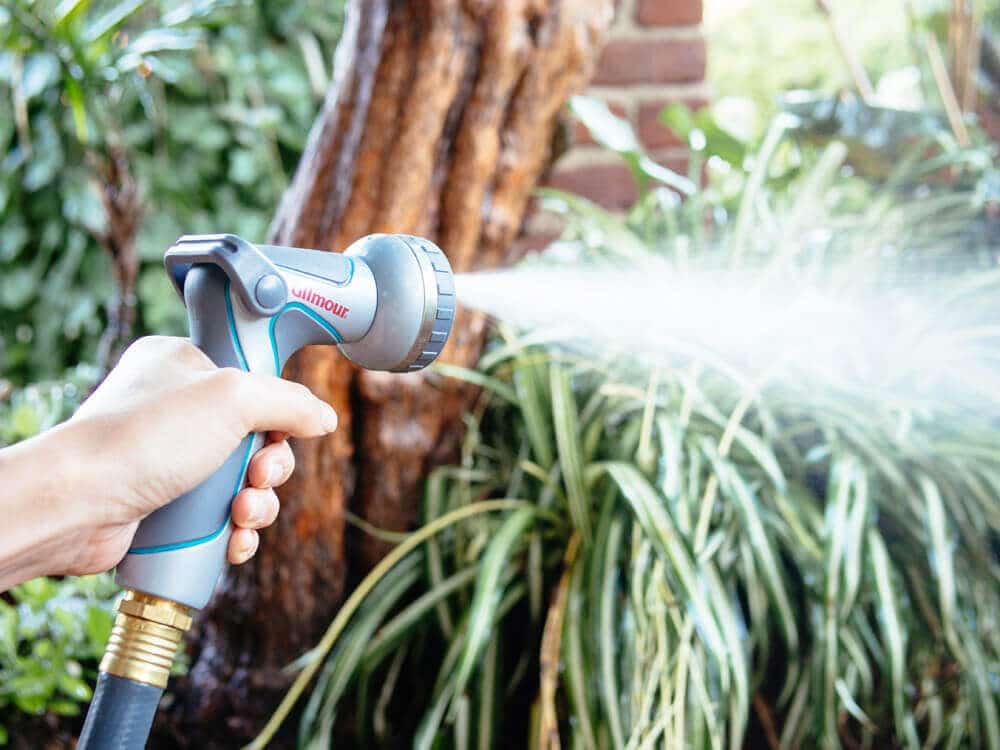
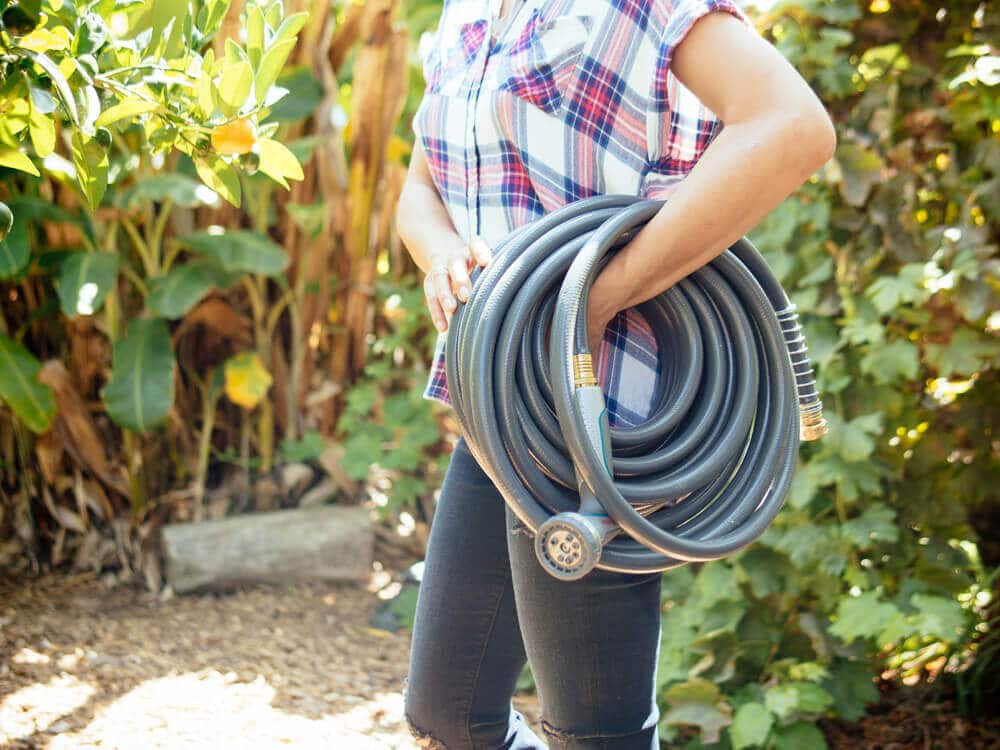
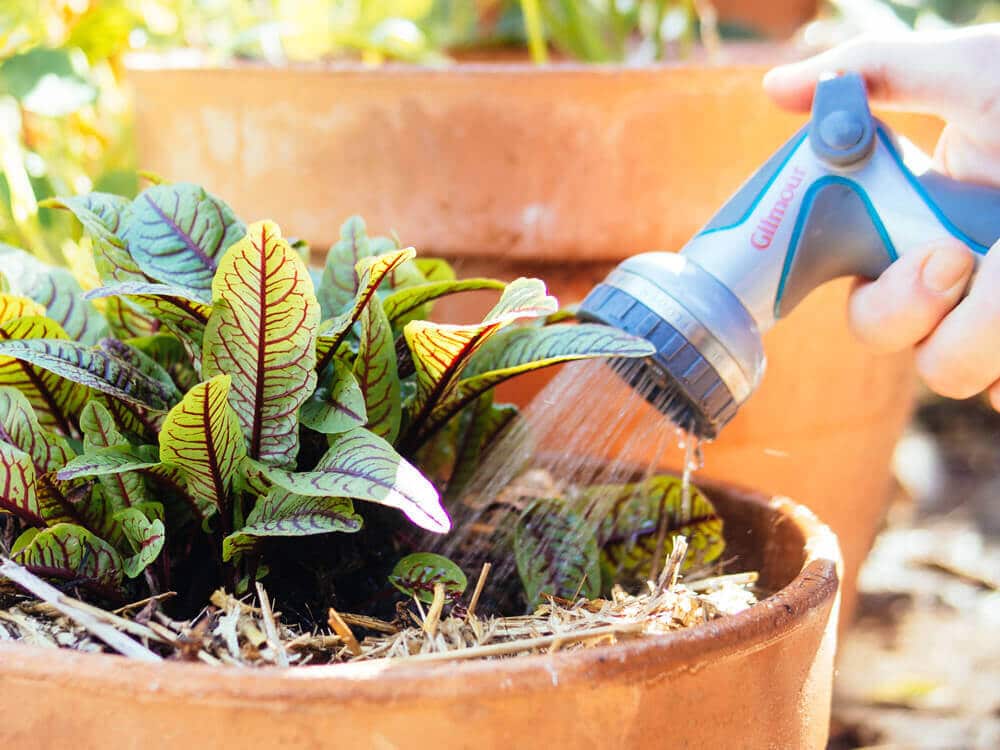
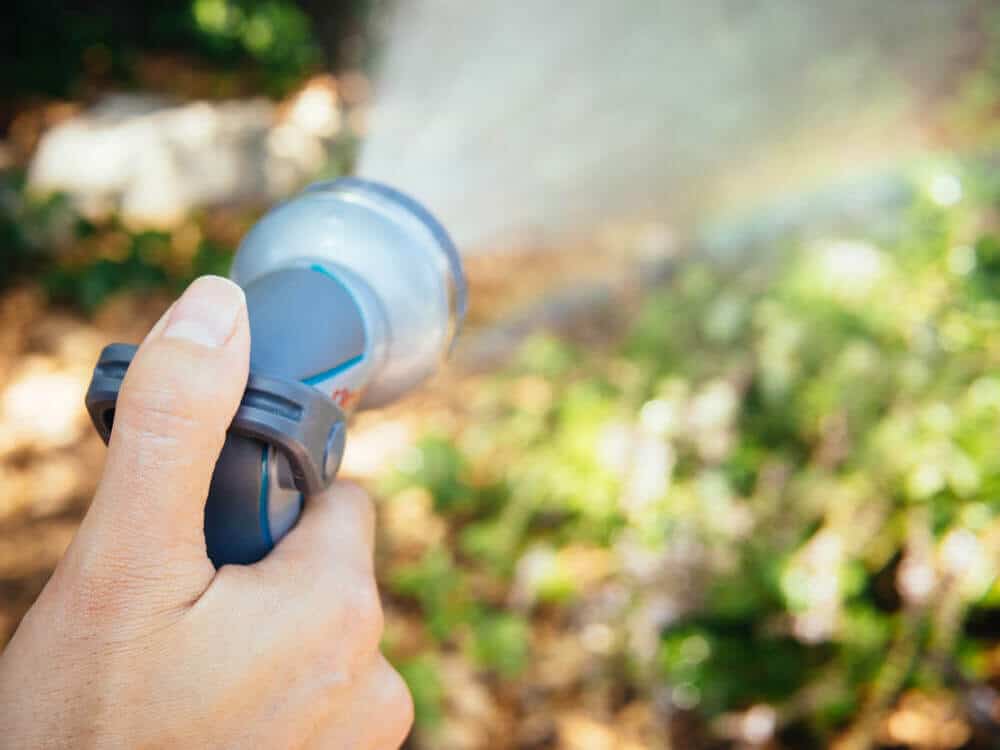
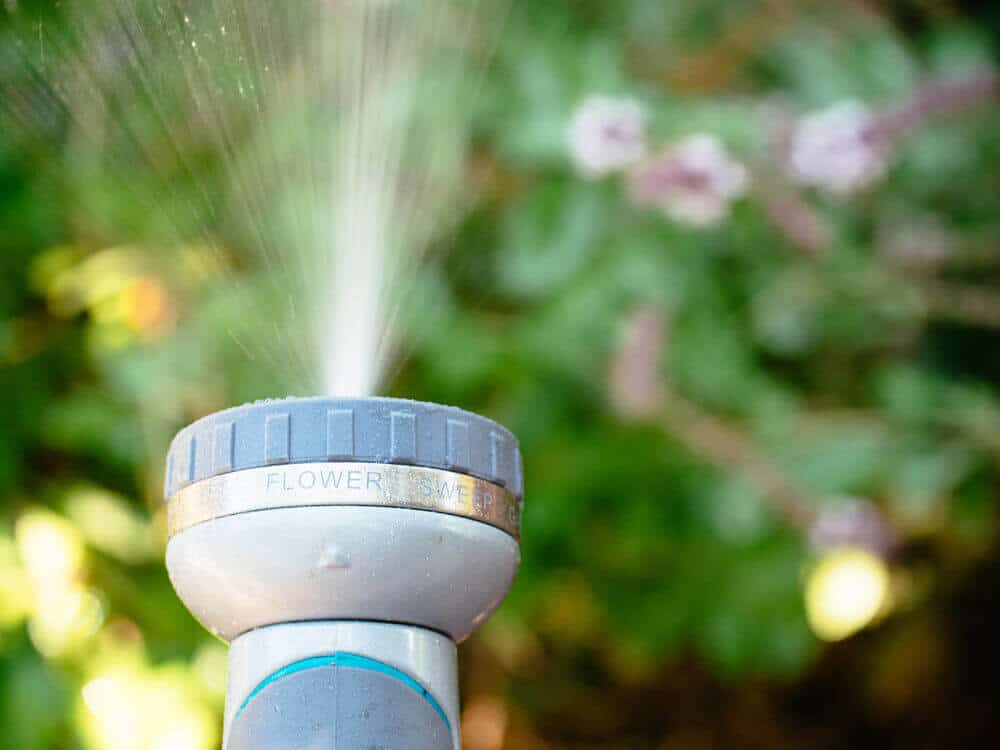
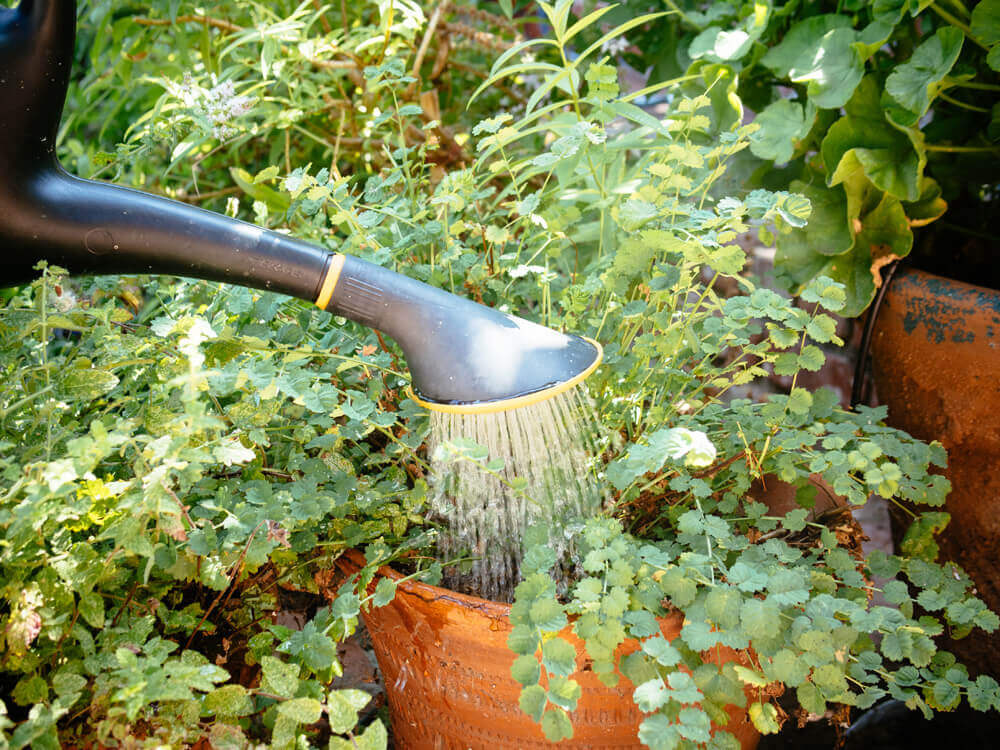
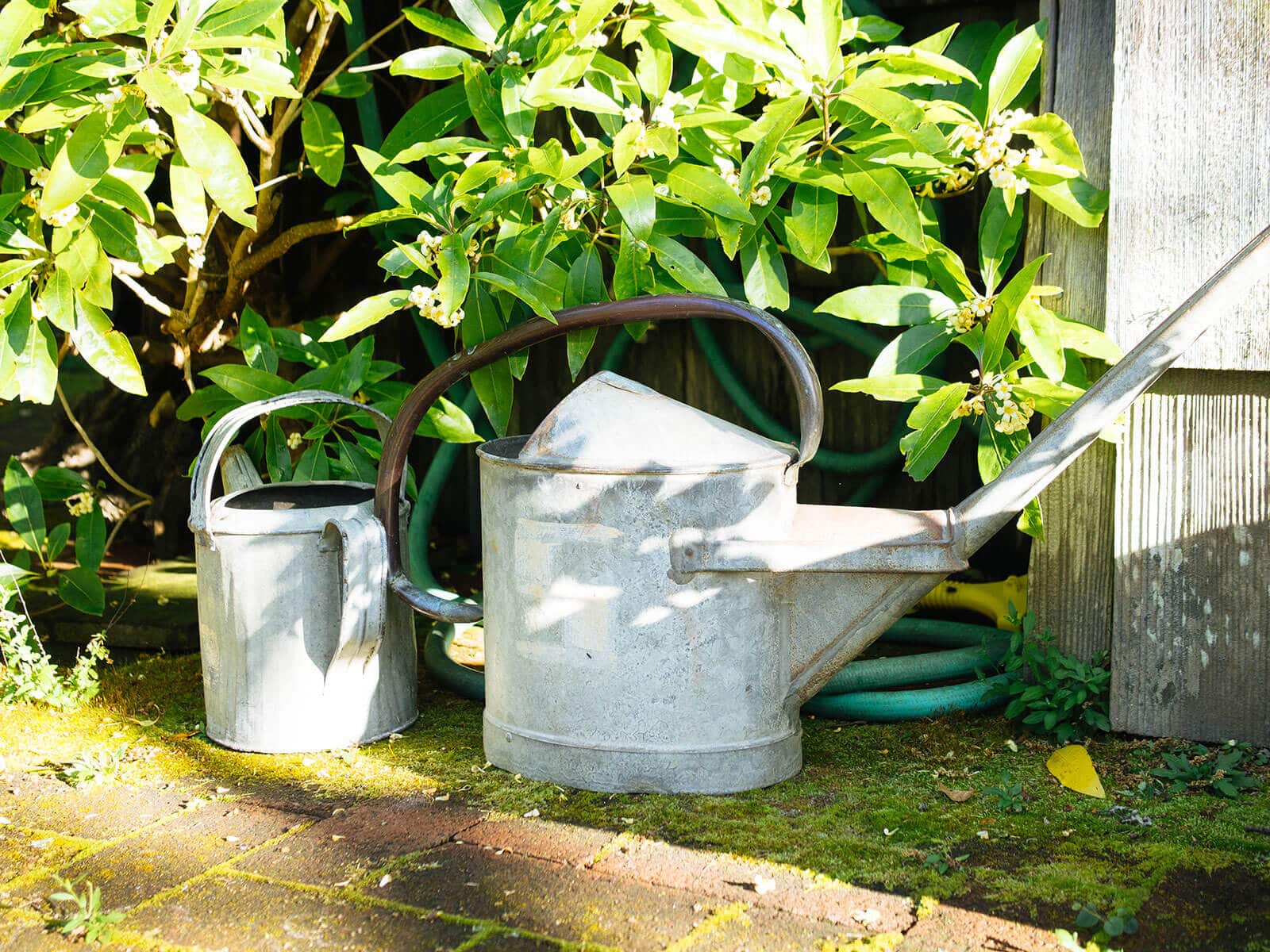













Hi, my biggest concern with watering during mid-summer het is the timing. I know it’s best to water early mornings, the problem is my work schedule, I work swing so I usually get home around 11:15pm. I go to bed around 3am so I’m not awake early morning and end up watering when I get home. Is that bad for the trees and plants? Should I do it right before bed at 3am?
These are some great tips to help plants survive a heatwave. Something that I’ve started doing is reserving water from my wading pool in tubs so that I can water my plants in containers. I wouldn’t suggest reserving the water if you wear sunscreen though since it may end up harming the plants.
What about some advice for hot and HUMID weather? My area has been hot, cloudy and humid for several weeks.
Shade cloth is what I recommend! (I know what you mean, I’m road-tripping across the South right now and it’s sweltering.) Also, make sure you’re growing varieties that are adapted for your climate.
In North Central Florida, where the USDA zone went from 8 to 9 when we lived there, winter was the ‘dry season, and summer was so hot and humid that tomatoes thrive over a shorter period than when I lived in Williamsburg, Mass., with a nominal (but not guaranteed) frost free period of almost 100 days. I learned to plant tomatoes very early as all but the cherry types and smaller were riddled with fungi starting in May. When we left I had been experimenting with tropical species, particularly greens, and we were growing all the papaya we could eat. In a hot climate where the soil is highly leached, focus on tree crops fills a hole in the parade of produce into the kitchen. I had one garden nexto the chicken coop fenced so that I could let the chickens in to forage in the hot months. (I fenced small inner areas with moringa & edible ground covers (perennial) & container plants here and there amid the small moringa ‘trees’. Chickens kept the rest from going to weeds to the benefit of interplanted citrus, Surinam cherries, one banana, etc. I had learned a lot about cold climate gardening, but I had to learn strategies that fit a different climate. When I came I thought I was moving to a year-long growing climate, but I learned that there about 5, most relatively short, growing seasons that overlapped depending on the crop in question. Learning to grow unfamiliar (to me) crops helped. It is much more efficient to select crops suited to the climate than to make familiar crops grow where they are not adapted. Of course this is not a hard rule but a general principle. The flooded beds once every several years took some serious readjusting, but I eventually saw that they eliminated root knot nematodes, making it posssible to grow sensitive crops for a few years following innudation. (I also made a couple of smaller gardens in between tree crops and bamboo plantings, which mostly rested AFTER a flood.
I use olla pots in all my containers for consistent moisture and water conservation. My water bill has dropped and my plant success risen.
I moved my potted tomato plants from the driveway to the east side of the garage.
They get the 1st 1/2 day of full sun, then light shade the rest of the day.
Temps here around 100F.
After watering things, I spray the roof and sides of the house with water.
It can cool down the house a little on a hot day and save a little on A/C.
Watering at the right time and shading your plants will help some, but don’t forget, the best method is to: buy more stuff!
Absolutely love the bedsheet idea – we started doing that a few years ago, going down to Goodwill to pick up a few white queen/king size sheets and it works perfectly as a shadecloth over our tomatoes and bell peppers.
However, I’d disagree strongly with watering in a heatwave from 4-7pm – at least here in Oregon, that’s the hottest part of the day and during summer, is when the direct sunlight is on the plants and the water evaporates very quickly. We prefer to water in early morning, but our alternative is 7-9pm when the sun is not directly beating down on everything.
The suggested times should only be used as a guideline — northern and southern climates will differ in the intensity of sunlight their garden receives throughout the day, as well as when sunset actually occurs, so everyone should exercise reasonable judgment when watering their plants.
Great tips. Early this spring I planted an apple seed and have watched the young tree grow like a weed….until I left town for a weekend and it died in the desiccating winds, crisped like fall leaves. My lesson learned: make sure you have the appropriate size pot for your plant because it will suck the soil dry.
For edible plants, especially, the larger the pot, the better!
Love your reviews. My tomatoes are planted in large fabric bags as you recommended. The leaves look great in the morning but will turn inward and start dropping later in the day when it’s warmer but the soil is still humid as of I don’t need to water yet. However if I water then they get back to normal. I’m not sure what to do as over watering is suppose to be bad for the plants. Help please!